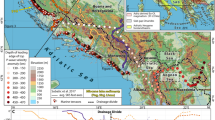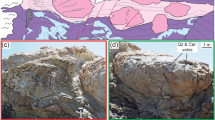Abstract
THE system of dikes in the uppermost mantle below oceanic spreading centres bears witness to the processes involved in the supply of melt to the ridge. Such systems cannot be studied on currently active ridges, but can be seen in ophiolites; in particular, the Oman ophiolite allows us to examine segments of a fast-spreading ridge1. Here we present a statistical analysis of the orientation of intrusions in the uppermost mantle section of the Oman ophiolite spreading centres, which points to the existence of two systems: dikes whose azimuth is parallel to the sheeted dikes (which we thus consider as related to the extensional lithospheric stress field) and sills, roughly parallel to the Moho2. Branching contemporaneous dikes and sills are frequently observed. We suggest that these relations can be explained by repeated sudden changes of the dominant stress field from lithospheric to asthenospheric. Such changes could result from the episodic relaxation of lithospheric stress in response to tension fracturing of the lithospheric lid, related to sudden melt surges. This episodic behaviour is recorded in the sheeted dike complex, with each dike (each about one metre wide) representing one of these fractures.
This is a preview of subscription content, access via your institution
Access options
Subscribe to this journal
Receive 51 print issues and online access
$199.00 per year
only $3.90 per issue
Buy this article
- Purchase on Springer Link
- Instant access to full article PDF
Prices may be subject to local taxes which are calculated during checkout
Similar content being viewed by others
References
Nicolas, A. Structures in Ophiolites and Dynamics of Oceanic Lithosphere (Kluwer, Dordrecht, 1989).
Nicolas, A., Boudier, F. & Ildefonse, B. in Magmatic Systems (ed. Ryan, M. P.) (Academic, Orlando, in the press).
Kelemen, P. B., Dick, H. J. B. & Quick, J. E. Nature 358, 635–641 (1992).
Nehlig, P. & Juteau, T. Tectonophysics 151, 199–221 (1988).
Nicolas, A. & Jackson, M. J. Petrology 23, 568–582 (1982).
Sleep, N. H. J. geophys. Res. 93, 10255–10272 (1988).
Foulger, G. R. et al. Nature 358, 488–490 (1992).
Rubin, A. M. Bull. Volcan. 52, 302–319 (1990).
Rabinowicz, M., Ceuleneer, G. & Nicolas, A. J. geophys. Res. 92, 3475–3486 (1987).
Su, W. & Buck, R. J. geophys. Res. 98, 12191–12205 (1993).
Scott, D. R. & Stevenson, D. J. J. geophys. Res. 94, 2973–2988 (1989).
Nicolas, A., Freydier, C., Godard, M. & Vauchez, A. Geology 21, 53–56 (1993).
Author information
Authors and Affiliations
Rights and permissions
About this article
Cite this article
IIdefonse, B., Nicolas, A. & Boudier, F. Evidence from the Oman ophiolite for sudden stress changes during melt injection at oceanic spreading centres. Nature 366, 673–675 (1993). https://doi.org/10.1038/366673a0
Received:
Accepted:
Issue Date:
DOI: https://doi.org/10.1038/366673a0
This article is cited by
-
Recognizing detachment-mode seafloor spreading in the deep geological past
Scientific Reports (2013)
-
Thermal structure of a fossil mantle diapir inferred from the distribution of mafic cumulates
Nature (1996)
-
Evidence from the Oman ophiolite for active mantle upwelling beneath a fast-spreading ridge
Nature (1994)
-
Upwelling beneath ocean ridges
Nature (1993)
Comments
By submitting a comment you agree to abide by our Terms and Community Guidelines. If you find something abusive or that does not comply with our terms or guidelines please flag it as inappropriate.



